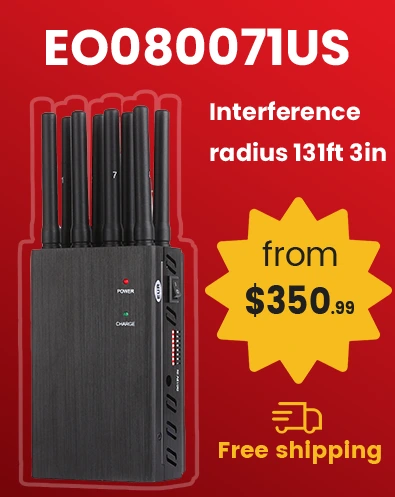The Korea Communications Commission (KCC) is the regulatory agency responsible for regulating signal jammers in South Korea. The KCC is responsible for monitoring and enforcing rules and regulations regarding the use of signal jammers in the country.
Cell Phone Jamming Device and Network Jammer in South Korea
South Korea is known for its advanced connectivity and widespread use of mobile communications technology. Since the country has multiple mobile operators, it is important to understand the frequency bands used by these operators in order to effectively block cell phone signals. In this article, we will look at the major mobile operators in South Korea and the frequencies they currently use.
In South Korea, it is not easy to obtain legal authorization to use signal jammers. The only exceptions are law enforcement and intelligence agencies, who are authorized to use signal jammers in the case of national security or police operations. The use of signal jammers by individuals or businesses for personal or commercial purposes is not allowed.
South Korea's telecommunications market is highly competitive and is mainly dominated by three major operators, providing a variety of services including mobile communications, broadband Internet, digital TV and enterprise services. South Korea is a leader in 4G LTE network coverage and speed levels worldwide, and is one of the first countries in the world to launch commercial 5G networks.
5G network coverage currently includes most major cities, such as Seoul, Busan, Daegu, Incheon, etc., and the service speed is much higher than 4G, supporting low latency and high-speed data transmission. South Korea's 5G network mainly uses 3.5 GHz and 28 GHz frequency bands, with the goal of achieving full popularization of 5G by 2025, covering major cities and rural areas across the country
SK Telecom is the largest telecommunications operator in South Korea and is part of the SK Group. Founded in 1984, SK Telecom's 4G LTE network has extensive coverage, covering almost all of South Korea's urban and rural areas, with very good signal quality. 5G services are provided using the 3.5 GHz and 28 GHz frequency bands, both of which help achieve a high-speed, low-latency network experience.
The following is the main frequency band information operated by SK Telecom:
- 2G (CDMA): 800 MHz (out of service).
- 3G (UMTS): 2100 MHz (phased out, decommissioning has begun).
- 4G LTE: 800 MHz, 1800 MHz, 2600 MHz (for high capacity and high-speed data transmission).
- 5G: 3.5 GHz and 28 GHz (provides ultra-high speed and low latency network experience).
KT Corporation (Korea Telecom Corporation) is the second largest telecommunications operator in South Korea. It was established in 1981 and was originally a state-owned enterprise, but was later privatized. KT's 4G LTE network covers a wide range, especially in urban areas, and its 4G network has very high speed and stability.
The following is information on the main frequency bands operated by KT Corporation:
- 2G(CDMA):800 MHz(discontinued).
- 3G (UMTS): 2100 MHz (being phased out).
- 4G LTE: 800 MHz, 1800 MHz, 2600 MHz (for high-speed data transmission).
- 5G: 3.5 GHz, 28 GHz, and 700 MHz (providing ultra-high speed, low latency, and wide coverage 5G network experience).
LG Uplus is the third largest telecommunications operator in South Korea and is affiliated to LG Group. The company was founded in 1996 as LG Telecom and later changed its name to LG Uplus in 2010. LG Uplus' 4G LTE network covers the whole country, especially in large cities and densely populated areas, where its network quality is good. Its 4G network performs well overall in South Korea and provides higher network bandwidth and lower latency in some areas.
The following is the main frequency band information operated by LG Uplus:
- 2G(CDMA):800 MHz(discontinued).
- 3G (UMTS): 2100 MHz (phased out, still used in some areas and devices).
- 4G LTE: 800 MHz, 1800 MHz, 2600 MHz (for high-speed data transmission and wide coverage).
- 5G: 3.5 GHz, 28 GHz, and 700 MHz (providing ultra-high-speed and low-latency 5G network services).
South Korea's mobile virtual network operator (MVNO) market is also gradually developing, mainly relying on the infrastructure of the three major operators to provide services.
Some well-known MVNOs include:
- CJ Hello Mobile:Services are primarily provided through SK Telecom's network.
- SK7mobile:Operated by SK Telecom, it targets consumers in the low-price market.
- LG HelloVision:Serviced through LG Uplus.
- Kakao Mobile:As a sub-brand of Kakao, a well-known Korean social platform, it provides mobile communication services based on SK Telecom's network.
Now that we have identified the frequency bands used by the major mobile operators in South Korea, we can decide which frequencies to cover to block cell phone signals in the country. To achieve effective blocking, it is recommended to cover the following frequency bands:
- 850 MHz (band 5)
- 900 MHz (band 8)
- 1800 MHz (band 3)
- 2100 MHz (Band 1)
- 2600 MHz (band 7)
By covering these frequencies, mobile phone signals from major Korean operators can be effectively blocked. However, it should be noted that blocking mobile phone signals is strictly regulated in many countries, including Korea. Before taking any signal blocking measures, it is necessary to comply with the local laws and regulations in force.
In summary, in order to block mobile phone signals in South Korea, it is recommended to cover the frequency bands used by major operators such as SK Telecom, KT Corporation, and LG Uplus. Taking the above frequencies into account, mobile phone signals in the country can be effectively blocked.
Our frequency checker tool will help you check all frequency bands used in all country.







